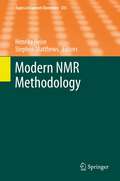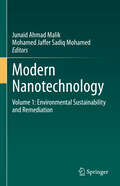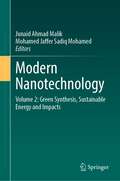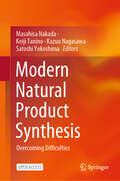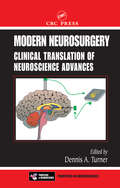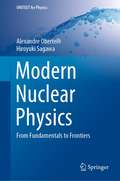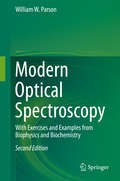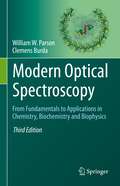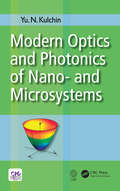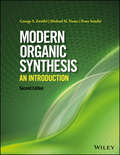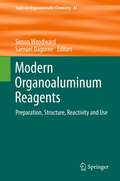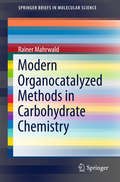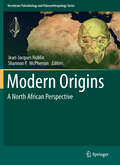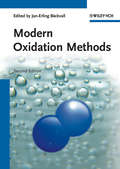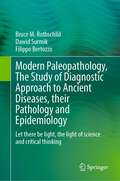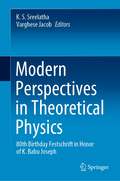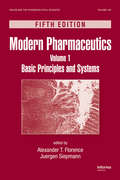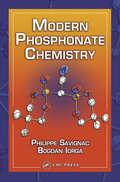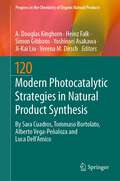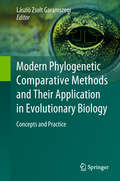- Table View
- List View
Modern NMR Methodology
by Stephen Matthews Henrike HeiseNMR Spectroscopy for Chemical Analysis at Low Magnetic Fields, by Stefan Glöggler, Bernhard Blümich, Stephan Appelt Dynamic Nuclear Hyperpolarization in Liquids, by Ulrich L. Günther NMR with Multiple Receivers, by Eriks Kupce TROSY NMR Spectroscopy of Large Soluble Proteins, by Yingqi Xu, Stephen Matthews Solid-State NMR Spectroscopy of Proteins, by Henrike Müller, Manuel Etzkorn, Henrike Heise Paramagnetic Solid-State Magic-Angle Spinning NMR Spectroscopy, by Guido Pintacuda, Gwendal Kervern
Modern Nanotechnology: Volume 1: Environmental Sustainability and Remediation
by Junaid Ahmad Malik Mohamed Jaffer Sadiq MohamedThis two-volume set provides a comprehensive overview of modern nanoscience, and encompasses advanced techniques of nanocomposite materials that make their way from the laboratory to the field for the revival of energy and environmental systems in a sustainable manner. It includes the design and the sophisticated fabrication of nanomaterials along with their potential energy and environmental applications, while looking at how nanoscience and nanotechnology can be used to promote environmentally friendly processes and strategies. The books' purpose is to promote eco-friendly methods and techniques by covering many elements of both the synthesis and uses of nanoparticles and nanofluids for energy and environmental engineering. They provide an up-to-date synthesis of nanocomposite materials for modern nanotechnology applications in the fields of environment protection, heterogeneous catalysis, wastewater treatment, fuel cells, electrochemical energy conversion, and storage applications. The set is designed for environmental scientists, nanotechnologists, chemists, engineers, and individuals seeking current research on nanotechnology and its applications in environmental engineering. Graduate students working in these fields will also find it a valuable resource. Volume 1 focuses on the fundamentals of nanotechnology, environmental protection, sustainable agriculture, bioremediation, bio-nanocomposites, and wastewater treatment.
Modern Nanotechnology: Volume 2: Green Synthesis, Sustainable Energy and Impacts
by Junaid Ahmad Malik Mohamed Jaffer Sadiq MohamedThis two-volume set provides a comprehensive overview of modern nanoscience, and encompasses advanced techniques of nanocomposite materials that make their way from the laboratory to the field for the revival of energy and environmental systems in a sustainable manner. It includes the design and the sophisticated fabrication of nanomaterials along with their potential energy and environmental applications, while looking at how nanoscience and nanotechnology can be used to promote environmentally friendly processes and strategies. The books' purpose is to promote eco-friendly methods and techniques by covering many elements of both the synthesis and uses of nanoparticles and nanofluids for energy and environmental engineering. They provide an up-to-date synthesis of nanocomposite materials for modern nanotechnology applications in the fields of environment protection, heterogeneous catalysis, wastewater treatment, fuel cells, electrochemical energy conversion, and storage applications. The set is designed for environmental scientists, nanotechnologists, chemists, engineers, and individuals seeking current research on nanotechnology and its applications in environmental engineering. Graduate students working in these fields will also find it a valuable resource. Volume 2 focuses on toxicological assessment, negative impacts of nanomaterials, green synthesis, energy conversion, and storage applications.
Modern Natural Product Synthesis: Overcoming Difficulties
by Masahisa Nakada Keiji Tanino Kazuo Nagasawa Satoshi YokoshimaIn this book, key experts in the field of total synthesis of natural products in Japan describe the details of their synthesis routes including unexpected reactions and syntheses. By presenting detailed stories behind the total synthesis developments, including those routes that were unsuccessful the book provides the reader with a better understanding of how other researchers devise their strategy and overcome difficulties in their studies. The contributions in the book have focused on highlighting the research from Japan however it is appealing to researchers and students worldwide. This compilation of cutting-edge natural product synthesis provides high-quality expertise, especially to graduate students and young researchers, regarding research on synthetic organic chemistry. It can be utilized as teaching material in university seminars as well as provide guidance to researchers in the area of total synthesis.This is an open access book.
Modern Neurosurgery: Clinical Translation of Neuroscience Advances
by Dennis A.Turner M.A.Focusing on how increased understanding of brain function affects clinical neuroscience, this incisive text explores the interface between neuroscience and clinical neuroscience advances by examining the hypotheses that drive this evolution. The author reviews the relevant underpinnings of new neurosurgical techniques, treatments, and conceptual ap
Modern Nuclear Chemistry
by David J. Morrissey Glenn T. Seaborg Walter D. LovelandWritten by established experts in the field, this book features in-depth discussions of proven scientific principles, current trends, and applications of nuclear chemistry to the sciences and engineering.• Provides up-to-date coverage of the latest research and examines the theoretical and practical aspects of nuclear and radiochemistry• Presents the basic physical principles of nuclear and radiochemistry in a succinct fashion, requiring no basic knowledge of quantum mechanics• Adds discussion of math tools and simulations to demonstrate various phenomena, new chapters on Nuclear Medicine, Nuclear Forensics and Particle Physics, and updates to all other chapters• Includes additional solved problems to help students and a solutions manual for all end of chapter problems for instructors• Reviews of 1st edition: "... an authoritative, comprehensive but succinct, state-of-the-art textbook ...." (The Chemical Educator) and "...an excellent resource for libraries and laboratories supporting programs requiring familiarity with nuclear processes ..." (CHOICE)
Modern Nuclear Physics: From Fundamentals to Frontiers (UNITEXT for Physics)
by Alexandre Obertelli Hiroyuki SagawaThis textbook is a unique and ambitious primer of nuclear physics, which introduces recent theoretical and experimental progresses starting from basics in fundamental quantum mechanics. The highlight is to offer an overview of nuclear structure phenomena relevant to recent key findings such as unstable halo nuclei, superheavy elements, neutron stars, nucleosynthesis, the standard model, lattice quantum chromodynamics (LQCD), and chiral effective theory. An additional attraction is that general properties of nuclei are comprehensively explained from both the theoretical and experimental viewpoints. The book begins with the conceptual and mathematical basics of quantum mechanics, and goes into the main point of nuclear physics – nuclear structure, radioactive ion beam physics, and nuclear reactions. The last chapters devote interdisciplinary topics in association with astrophysics and particle physics. A number of illustrations and exercises with complete solutions are given. Each chapter is comprehensively written starting from fundamentals to gradually reach modern aspects of nuclear physics with the objective to provide an effective description of the cutting edge in the field.
Modern Nucleophilic Aromatic Substitution
by Francois TerrierThis book provides a comprehensive overview of nucleophilic aromatic substitutions, focusing on the mechanistic and synthetic features that govern these reactions. The first chapter presents a detailed mechanistic analysis of the factors determining the feasibility of SNAr substitutions, providing decisive information to predict regioselectivity of many reactions and to define the conditions for concerted SNAr processes. Reflecting the key role played by these species as intermediates in most SNAr reactions, chapter 2 then discusses the chemistry of anionic sigma-complexes. Chapter 3 describes the concept of superelectrophilicity in SNAr substitutions, as it has recently emerged from the reactivity of strongly electron-deficient aromatic and heteroaromatic structures. The numerous synthetic applications are considered in depth in the chapters 4 and 5 that follow on intermolecular and intramolecular nucleophilic aromatic substitutions. Then, chapter 6 focuses on substitutions proceeding formally through displacement of a hydride ion, a hot topic in the field. The final chapter brings together concise yet comprehensive discussions surrounding SNAr photosubstitutions, radical substitutions, and ANRORC substitutions.Authored by a highly respected chemist who has contributed greatly to the field over the past two decades, this is a valuable information source for all organic chemists working in academia or the pharmaceutical and agrochemical industries.
Modern Ophthalmic Optics
by José Alonso José A. Gómez-Pedrero Juan A. QuirogaThis book is a comprehensive account of the most recent developments in modern ophthalmic optics. It makes use of the powerful matrix formalism to describe curvature and power, providing a unified view of the optical and geometrical properties of lenses. This unified approach is applicable to the design and properties of not only spectacle lenses, but also contact and intraocular lenses (IOL). The newest developments in lens design, manufacturing and testing are discussed, with an emphasis on the description of free-form technology, which has surpassed traditional manufacturing methods and allows digital lenses to be specifically designed with the unique requirements of the user. Other important topics which are covered include modern lens materials, up-to-date lens measuring techniques, contact and intraocular lenses, progressive power lenses, low vision aids, ocular protection and coatings. Providing a broad overview of recent developments in the field, it is ideal for researchers, manufacturers and practitioners involved in ophthalmic optics.
Modern Optical Spectroscopy
by William W. ParsonThis textbook offers clear explanations of optical spectroscopic phenomena and shows how spectroscopic techniques are used in modern molecular and cellular biophysics and biochemistry. The topics covered include electronic and vibrational absorption, fluorescence, resonance energy transfer, exciton interactions, circular dichroism, coherence and dephasing, ultrafast pump-probe and photon-echo spectroscopy, single-molecule and fluorescence-correlation spectroscopy, Raman scattering, and multiphoton absorption. This revised and updated edition provides expanded discussions of quantum optics, metal-ligand charge-transfer transitions, entropy changes during photoexcitation, electron transfer from excited molecules, normal-mode calculations, vibrational Stark effects, studies of fast processes by resonance energy transfer in single molecules, and two-dimensional electronic and vibrational spectroscopy. The explanations are sufficiently thorough and detailed to be useful for researchers and graduate students and advanced undergraduates in chemistry, biochemistry and biophysics. They are based on time-dependent quantum mechanics, but are developed from first principles with a clarity that makes them accessible to readers with little prior training in this field. Extra topics and highlights are featured in special boxes throughout the text. The author also provides helpful exercises for each chapter.
Modern Optical Spectroscopy: From Fundamentals to Applications in Chemistry, Biochemistry and Biophysics
by William W. Parson Clemens BurdaThe 3rd edition of this textbook offers clear explanations of optical spectroscopic phenomena and shows how spectroscopic techniques are used in modern chemistry, biochemistry and biophysics.Topics included are: electronic and vibrational absorption fluorescence symmetry operations and normal-mode calculations electron transfer from excited moleculesenergy transferexciton interactions electronic and vibrational circular dichroismcoherence and dephasingultrafast pump-probe and photon-echo spectroscopy single-molecule and fluorescence-correlation spectroscopyRaman scatteringmultiphoton absorption quantum optics and non-linear opticsentropy changes during photoexcitationelectronic and vibrational Stark effects studies of fast processes in single moleculestwo-dimensional electronic and vibrational spectroscopyThis revised and updated edition provides expanded discussions of laser spectroscopy, crystal symmetry, birefringence, non-linear optics, solar cells and light-emitting diodes. The explanations are sufficiently thorough and detailed to be useful for researchers, graduate students and advanced undergraduates in chemistry, biochemistry and biophysics. They are based on time-dependent quantum mechanics, but are developed from first principles so that they can be understood by readers with little prior training in the field. Additional topics and highlights are presented in special boxes in the text. The book is richly illustrated with color figures throughout. Each chapter ends with a section of questions for self-examination.
Modern Optics and Photonics of Nano- and Microsystems
by Yu. N. KulchinThis book cover advances in the study of processes of nonlinear propagation of continuous and pulsed laser radiation in a continuous and micro structured optical media. It details distributed fiber-optical measuring systems, the physical basis of ultra-low laser cooling of atoms, and studies of optical and nonlinear optical properties of nanostructured heterogeneous systems.
Modern Organic Synthesis: An Introduction
by George S. Zweifel Michael H. Nantz Peter SomfaiThis book bridges the gap between sophomore and advanced / graduate level organic chemistry courses, providing students with a necessary background to begin research in either an industry or academic environment. • Covers key concepts that include retrosynthesis, conformational analysis, and functional group transformations as well as presents the latest developments in organometallic chemistry and C–C bond formation• Uses a concise and easy-to-read style, with many illustrated examples• Updates material, examples, and references from the first edition• Adds coverage of organocatalysts and organometallic reagents
Modern Organoaluminum Reagents
by Simon Woodward Samuel DagorneJanusz Lewiński and Andrew E. H. Wheatley: Simple trivalent organoaluminum species: perspectives on structure, bonding and reactivity.- Stephan Schulz: Organoaluminum complexes with bonds to s-block, p-block, d-block, and f-block metal centers.- Samuel Dagorne and Christophe Fliedel: Low valent organoaluminium (+I, +II) species.- Rudolf Wehmschulte: Organoaluminum species in homogeneous polymerization catalysis.- Paul Knochel, Tobias Blümke, Klaus Groll and Yi-Hung Chen: Preparation of Organoalanes for Organic Synthesis.- Yuki Naganawa and Keiji Maruoka: Reactions Triggered by Lewis Acidic Organoaluminum Species.- Usein M. Dzhemilev and Vladimir A. D'yakonov: Hydro-, Carbo- and Cycloalumination of Unsaturated Compounds.- Andreas Kolb and Paultheo von Zezschwitz: Organoaluminum Couplings to Carbonyls, Imines and Halides.- Oscar Pàmies and Montserrat Diéguez: Conjugate Addition of Organoaluminum Species to Michael Acceptors and Related Processes.
Modern Organocatalyzed Methods in Carbohydrate Chemistry
by Rainer MahrwaldThis brief presents a valuable and concise overview of organocatalytic methodologies in carbohydrate chemistry. It includes glycosylation processes with de novo syntheses of carbohydrates and chain elongation of carbohydrates. The author, an academic of international distinction, goes on to make comparisons between traditional organic and metalorganic transformations.
Modern Origins
by Jean-Jacques Hublin Shannon P. McpherronOver the last decade, Africa has taken a central position in the search for the timing and mechanisms leading to modern human origins, and the rich archaeological and human paleontological record of North Africa is critical to this search. In this volume, we bring together new research into the archaeology, human paleontology, chronology, and environmental context of modern human origins in North Africa. The result is a volume that better integrates the North African record into the modern human origins debate and at the same time highlights the research questions that are currently the focus of continued work in the area.
Modern Oxidation Methods
by Jan–Erling BäckvallWhile rust is an unwanted oxidation reaction, there are also many other useful oxidation reactions that are extremely important and number among the most commonly used reactions in the chemical industry. This completely revised, updated second edition now includes additional sections on industrial oxidation and biochemical oxidation. Edited by one of the world leaders in the field, high-quality contributions cover every important aspect from classical to green chemistry methods: - Recent Developments in Metal-catalyzed Dihydroxylation of Alkenes - Transition Metal-Catalyzed Epoxidation of Alkenes - Organocatalytic Oxidation. Ketone-Catalyzed Asymmetric Epoxidation of Alkenes and Synthetic Applications - Catalytic Oxidations with Hydrogen Peroxide in Fluorinated Alcohol Solvents - Modern Oxidation of Alcohols using Environmentally Benign Oxidants - Aerobic Oxidations and Related Reactions Catalyzed by N-Hydro xyphthalimide - Ruthenium-Catalyzed Oxidation for Organic Synthesis - Selective Oxidation of Amines and Sulfides - Liquid Phase Oxidation Reactions Catalyzed by Polyoxometalates - Oxidation of Carbonyl Compounds - Manganese-Catalyzed Oxidation with Hydrogen Peroxide - Biooxidation with Cytochrome P450 Monooxygenases By providing an overview of this vast topic, the book represents an unparalleled aid for organic, catalytic and biochemists working in the field.
Modern Paleopathology, The Study of Diagnostic Approach to Ancient Diseases, their Pathology and Epidemiology: Let there be light, the light of science and critical thinking
by Bruce M. Rothschild Dawid Surmik Filippo BertozzoThe study of paleopathology has two very different constituencies, the medical scientist and the zoologist/paleontologist/anthropologist. Their investigative procedures and professional jargon are different, sometimes to the point of mutual incomprehensibility. Paleontologists/anthropologists/zoologists have a limited data base for the characterization and interpretation of pathology. This must come from the human and veterinary medical experience.What, beyond intellectual satisfaction, can the health care community expect from this relationship? The past history of the appearance and dispersal of infectious disease and cancer is of considerable theoretical importance and leads to new insights on the nature and transmission of diseases that are otherwise ambiguous. The discovery of rheumatoid arthritis in pre-Columbian North America exemplifies insights gained.The current effort delineates osseous impact of disease (as manifest in clinical populations diagnosed in life), representation in the zoologic, paleontologic and anthropologic record, and assessment techniques that can be confidently applied. The chapters form “columns” that provide the foundation for scientific critical thinking. The actual integration of the information is in its application. Our purpose is to provide a data base and atlas of actually documented skeletal impact of diseases (as population phenomenon), an initial data base of reported skeletal pathology, and a methodology for expanding this to new arenas.The first section of the book examines the scientific basis of paleopathology, its transition from speculation-based musings, resolution of misconceptions and the denouement of paleo-epidemiology. The second section provides holistic analysis of the gamut of pathology/diseases with significant skeletal impact, with a validated archeologic/zoological/paleontological record. The third section provides a glossary to resolve the semantic challenges inherent to interdisciplinary efforts. The fourth section provides an atlas of pathology representation in the fossil record. Ultimately, this book intends to present a scientifically-validated approach to recognition of disease in the archeological, zoological and paleontological record, superseding previous speculation-based offerings.
Modern Particle Physics
by Mark ThomsonUnique in its coverage of all aspects of modern particle physics, this textbook provides a clear connection between the theory and recent experimental results, including the discovery of the Higgs boson at CERN. It provides a comprehensive and self-contained description of the Standard Model of particle physics suitable for upper-level undergraduate students and graduate students studying experimental particle physics. Physical theory is introduced in a straightforward manner with full mathematical derivations throughout. Fully-worked examples enable students to link the mathematical theory to results from modern particle physics experiments. End-of-chapter exercises, graded by difficulty, provide students with a deeper understanding of the subject. Online resources available at www. cambridge. org/MPP feature password-protected fully-worked solutions to problems for instructors, numerical solutions and hints to the problems for students and PowerPoint slides and JPEGs of figures from the book.
Modern Perspectives in Theoretical Physics: 80th Birthday Festschrift in Honor of K. Babu Joseph
by K. S. Sreelatha Varghese JacobThis book highlights the review of articles in theoretical physics by the students of Professor K. Babu Joseph, as a Festschrift for his 80th Birthday. This book is divided into four sections based on the contributions of Babu Joseph and his students. The four sections are Cosmology, High Energy Physics, Mathematical Physics and Non-linear Dynamics and its applications.
Modern Pharmaceutics Volume 1: Basic Principles and Systems, Fifth Edition (Drugs and the Pharmaceutical Sciences)
by Juergen Siepmann Alexander T. FlorenceWith over 100 illustrations, Volume 1 addresses the core disciplines of pharmaceutics (absorption, PK, excipients, tablet dosage forms, and packaging), and explores the challenges and paradigms of pharmaceutics.Key topics in Volume 1 include: principles of drug absorption, chemical kinetics, and drug stability pharmacokinetics the effect of rout
Modern Pharmaceutics, Volume 2: Applications and Advances, Fifth Edition (Drugs and the Pharmaceutical Sciences)
by Juergen Siepmann Alexander T. FlorenceVolume 2 addresses the applications and approaches in advanced drug delivery systems, including transdermal, pulmonary, and ocular routes. In addition, this text discusses the impact of the shift to personalized medicines in the fields of pharmaceutical biotechnology, pharmacogenomics, and nanotechnology.Volume 2 investigates: sustained- and contr
Modern Phosphonate Chemistry
by Philippe Savignac Bogdan IorgaA century after their discovery, phosphonates have become important compounds recognized both for their use as efficient reagents in organic synthesis and for their biological and industrial importance. This unique, up-to-date reference presents a concise summary of the state of the art in phosphonate chemistry, covering the role of phosphonates in
Modern Photocatalytic Strategies in Natural Product Synthesis (Progress in the Chemistry of Organic Natural Products #120)
by A. Douglas Kinghorn Heinz Falk Simon Gibbons Yoshinori Asakawa Ji-Kai Liu Verena M. DirschThis book presents recent reports of total syntheses involving a photocatalytic reaction as a key step in the methodology. Modern photocatalysis has proven its generality for the development and functionalization of native functionalities. To date, the field has found broad applications in diverse research areas, including the total synthesis of natural products. Among the selected examples presented in this book, it highlights how the photocatalytic process proceeds in a highly chemo-, regio-, and stereoselective manner, thereby allowing the rapid access to structurally complex architectures under light-driven conditions.
Modern Phylogenetic Comparative Methods and Their Application in Evolutionary Biology: Concepts and Practice
by László Zsolt GaramszegiPhylogenetic comparative approaches are powerful analytical tools for making evolutionary inferences from interspecific data and phylogenies. The phylogenetic toolkit available to evolutionary biologists is currently growing at an incredible speed, but most methodological papers are published in the specialized statistical literature and many are incomprehensible for the user community. This textbook provides an overview of several newly developed phylogenetic comparative methods that allow to investigate a broad array of questions on how phenotypic characters evolve along the branches of phylogeny and how such mechanisms shape complex animal communities and interspecific interactions. The individual chapters were written by the leading experts in the field and using a language that is accessible for practicing evolutionary biologists. The authors carefully explain the philosophy behind different methodologies and provide pointers - mostly using a dynamically developing online interface - on how these methods can be implemented in practice. These "conceptual" and "practical" materials are essential for expanding the qualification of both students and scientists, but also offer a valuable resource for educators.
